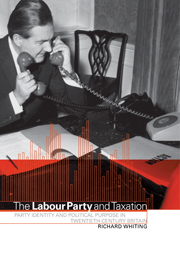Book contents
- Frontmatter
- Contents
- List of tables
- Acknowledgements
- List of abbreviations
- Introduction: Taxation and political debate
- 1 Struggles within a liberal inheritance, 1906–1940
- 2 The changing balance of tax interests, 1940–1954
- 3 The Kaldor era, 1951–1965
- 4 Social democracy examined, 1965–1970
- 5 Defensive positions, 1970–1979
- 6 Epilogue: New Labour, old problems?
- 7 Conclusion
- Select bibliography
- Index
2 - The changing balance of tax interests, 1940–1954
Published online by Cambridge University Press: 07 August 2009
- Frontmatter
- Contents
- List of tables
- Acknowledgements
- List of abbreviations
- Introduction: Taxation and political debate
- 1 Struggles within a liberal inheritance, 1906–1940
- 2 The changing balance of tax interests, 1940–1954
- 3 The Kaldor era, 1951–1965
- 4 Social democracy examined, 1965–1970
- 5 Defensive positions, 1970–1979
- 6 Epilogue: New Labour, old problems?
- 7 Conclusion
- Select bibliography
- Index
Summary
Many of the broader political difficulties which had dogged Labour's tax strategy in the 1920s appeared to have been removed by 1945. The doubts about Labour's capacity and purpose, which had shown through in criticisms of the party's tax policies, had been swept away by participation in the wartime government and electoral triumph. Because the Second World War had, domestically, been a more stable experience than the First, it encouraged the translation of its methods of government into peacetime. The possibility of controlling the economy, which was at the heart of Labour's thinking, had been strikingly confirmed by wartime government. But, as in 1914–18, the taxing strength of the state had increased far more in wartime than would have been conceivable in peace. A party pamphlet commented in 1940, ’the limit of taxation is what you can get away with – in the atmosphere of war the task is much easier'. By 1941/2 incomes at all levels were facing higher taxes. Even those on £500 a year only retained 69 per cent of their earnings after tax, whereas they had kept 86 per cent in 1937/8. Higher up the effects were greater still, and at its simplest it was impossible to earn a post-tax income of £5,000 even at a salary ten times higher. These tax increases were especially dramatic in terms of income tax.
- Type
- Chapter
- Information
- The Labour Party and TaxationParty Identity and Political Purpose in Twentieth-Century Britain, pp. 61 - 129Publisher: Cambridge University PressPrint publication year: 2001



